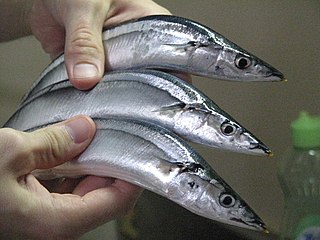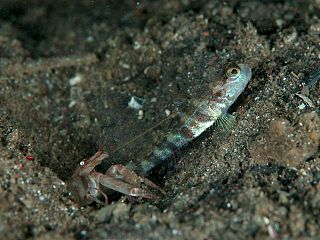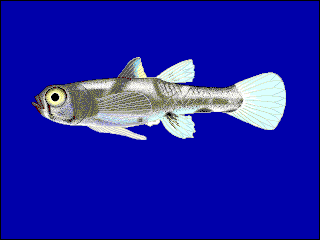
Meguro is a special ward in the Tokyo Metropolis in Japan. The English translation of its Japanese self-designation is Meguro City. The ward was founded on March 15, 1947.

The Tokyo Metro Hibiya Line is a subway line in Tokyo, Japan, owned and operated by Tokyo Metro. The line was named after the Hibiya area in Chiyoda's Yurakucho district, under which it passes. On maps, diagrams and signboards, the line is shown using the color silver, and its stations are given numbers using the letter "H".

The Pacific saury is species of fish in the family Scomberesocidae. Saury is a seafood in several East Asian cuisines and is also known by the name mackerel pike.

Exyrias is a genus of fish in the family Gobiidae, mostly native to marine waters of the Indian Ocean and the western Pacific Ocean with one freshwater species known from the Philippines.

Exyrias akihito is a species of marine goby. Since the recent description of this species it has been found to have a wide distribution in the western Pacific including the Great Barrier Reef, New Guinea, Indonesia, the Philippines and the Yaeyama Islands, Japan. One individual was photographed in Palau, and on January 13, 2005 one was caught in the lagoon of Majuro Atoll in the Marshall Islands. This animal had only 9 soft rays in its dorsal fin instead of the normal 10, a congenital abnormality known to occasionally occur in gobies and other fish.

Enneapterygius is a genus of fish in the family Tripterygiidae found in the Indian and Pacific Ocean.

Glossogobius is a genus of gobies native to fresh, brackish and marine waters from Africa to the coasts of the western Pacific Ocean. They are found in Madagascar, South Africa, Japan, Thailand, Australia, Indonesia, Bangladesh, the Philippines, Taiwan, Papua New Guinea, Singapore, Malawi, Eswatini, Botswana, Kenya, Zimbabwe, Tanzania, Mozambique, the Solomon Islands, Palau, Fiji, New Caledonia, India, Laos, Sri Lanka, Myanmar, Borneo, Nepal, Brunei Darussalam, Micronesia, Cambodia, Vietnam, China, Réunion, the Seychelles, Mauritius, the Caroline Islands, Vanuatu, Malaysia and Russia. The genus also includes a troglobitic species, G. ankaranensis.
The Buenos Aires Japanese Gardens are a public space administered by the non-profit Japanese Argentine Cultural Foundation in Buenos Aires, Argentina. They are among the largest Japanese gardens in the world outside Japan.

Akihito is a member of the Imperial House of Japan who reigned as the 125th emperor of Japan from 1989 until his abdication in 2019. The era of his rule was named the Heisei era, Heisei being an expression of achieving peace worldwide.

The Gobionellinae are a subfamily of fish which was formerly classified in the family Gobiidae, the gobies, but the 5th Edition of Fishes of the World classifies the subfamily as part of the family Oxudercidae. Members of Gobionellinae mostly inhabit estuarine and freshwater habitats; the main exception is the genus Gnatholepis, which live with corals in marine environments. The subfamily is distributed in tropical and temperate regions around the world with the exception of the northeastern Atlantic Ocean, the Mediterranean Sea, and the Ponto-Caspian region. It includes around 370 species and 55 genera: Wikipedia articles about genera list about 389 species.
Japigny kirschbaum is a species of glass knifefish described in 2011 from the Approuague, Mana and Maroni rivers in French Guiana. It is the only member of its genus. It reaches up to 22 cm (8.7 in) in total length and is brownish-dusky with a pattern of dark-and-pale broad bands.

Sternopygus is a genus of glass knifefishes found in tropical and subtropical South America, and Panama. They inhabit a wide range of freshwater habitats, from fast-flowing rivers to essentially static waters in floodplains, and shallow habitats to the bottom of deep rivers. S. macrurus will even visit brackish mangrove to feed.

The Sicydiinae are a small subfamily of freshwater gobies, with only nine genera. They are usually found in fast-moving mountain streams in tropical islands. They are characterized by highly developed rounded suction discs and an amphidromous lifecycle. Adult lengths range from 2 to 15 cm. Some species are popular in the aquarium trade. The genera included under Sicydiinae are:

Meguro motorcycles were built by Meguro Manufacturing Co motorcycle works (目黒製作所), founded by Nobuji Murata and a high-ranking naval officer, Takaji Suzuki, in 1937. One of the first Japanese motorcycle companies, it became a partner of Kawasaki Heavy Industries Ltd, and was eventually absorbed. Named after a district of Tokyo, Meguro had its roots in Murato Iron Works, which was established in 1924. Meguro Seisakusho, which had once developed a copy of a Harley-Davidson V-twin, was established to design and build gearboxes for the nascent Japanese motorcycle industry. Abe Industries, which had once produced its own motorcycle, merged with Meguro in 1931. The brand is being revived by Kawasaki with a new K3 model to be introduced in Japan on February 1, 2021.
Akihito is a genus of gobies native to streams in Vanuatu.
Akihito vanuatu, the Vanuatu's emperor, is a species of fish in the family Oxudercidae, the gobies. It is endemic to Vanuatu, where it inhabits streams and pools. Males of this species can reach a length of 4.3 centimetres (1.7 in) SL while females can reach 3.9 centimetres (1.5 in) SL.
Cristatogobius is a genus of gobies native to the western Pacific Ocean.

Myersina is a genus of ray-finned fish from the family Gobiidae, the true gobies which are found from the Atlantic coast of South Africa through the Indian Ocean to the western Pacific Ocean. The generic name honours the American ichthyologist George S. Myers (1905-1985) who was a younger colleague of Herre's at the time at which he described the genus and who went on to be president of the American Society of Ichthyologists and Herpetologists, the head of the Division of Fishes at the United States National Museum and an ichthyologist for the United States Fish and Wildlife Service.

Pandaka is a genus of fish in the goby subfamily, Gobionellinae, native to fresh, brackish and marine waters of Asia and the western Pacific Ocean. Some species in the genus are among the smallest fish in the world; the male P. pygmaea can be just 9 mm (0.35 in) in standard length at maturity.
Platygobiopsis is a genus of gobies native to the western Pacific Ocean.














